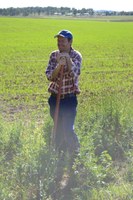Green Army Restoration Success at Putta Bucca Wetlands
The Green Army is a Federal Government program aimed at achieving positive environmental outcomes while giving young people training and practical experience. The Mid Western Regional Council recently sponsored a Green Army project in the region. The team is run by Conservation Volunteers Australia and has nine participants aged between 18 and 24. There are five different sites where they are working; Adams Lead Reserve in Gulgong, Peoples Park in Gulgong, Rylstone common, Flirtation Hill in Mudgee and Putta Bucca Wetlands. The program runs over a period of six months.
At Putta Bucca the Green Army have been working on weed control, tree planting and general maintenance. To date weed control has focused on bridal creeper (Asparagus asparagoides), Hemlock (Conium maculatum), African boxthorn (Lycium ferocissimum), and Noogoora Burr (Xanthium pungens). There have been 100 River She-oak (Casuarina cunninghamiana) and River Red Gum (Eucalyptus camaldulensis) planted along the river with the aim being to improve riparian vegetation and reduce bank erosion. The majority of these were planted on the opposite bank to the Putta Bucca wetlands with the cooperation of a local landholder. The aim of these plantings is to improve the riparian vegetation and reduce bank erosion. There have also been some Bottlebrushes (Callistemon citrinus) planted around the bird hides to conceal the hides and attract birds. Maintenance work around the wetlands has included painting, graffiti removal and repairing benches. Further work planned for Putta Bucca includes follow up weed control, poisoning of the Chinese Elms and more tree plantings. Bruce Christie from the Local Land Services in Mudgee conducted a water monitoring demonstration with the team comparing the water quality in the old quarry with the Cudgegong River. The demonstration gave the participants an understanding of the importance of river and wetland health in the landscape and how water monitoring can be used as a measure of this. A range of different measures of water quality were demonstrated including subjective measures such as visual assessment of water quality and vegetation quality and objective measurements such as temperature, salinity and turbidity. Bruce also showed the team how sampling aquatic invertebrates can give an indication of wetland health by looking at the sensitivity to disturbance of the species present. The results of the water quality testing showed that the Cudgegong River was in slightly better condition than the wetlands. The Green Army has given the participants a chance to learn important skills such as tree planting, plant identification and different weed control methods. The team have also been taking advantage of the Putta Bucca wetlands to learn to identify some of the local bird species. The program has been achieving positive environmental outcomes in the region as well as inspiring young people to become more actively involved with environmental work.





